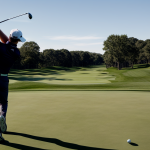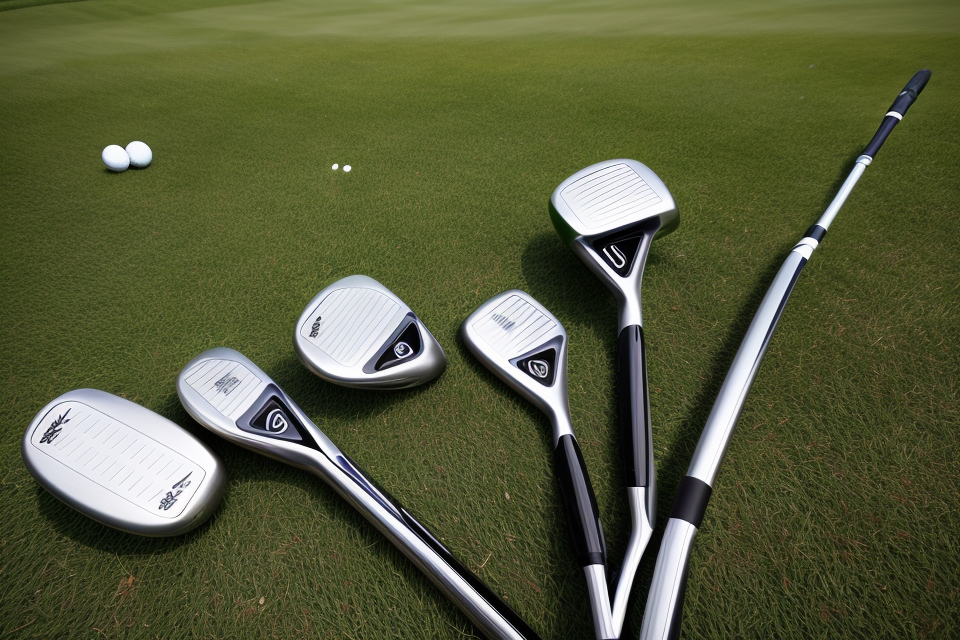Choosing the right golf club is crucial to your game, as it can affect your shot accuracy and distance. With so many options available, it can be overwhelming to decide which one to use. This guide will provide you with a comprehensive understanding of how to choose the right golf club for your game. We will discuss the factors to consider when selecting a golf club, such as your skill level, swing speed, and the type of shot you want to make. By the end of this guide, you will have the knowledge and confidence to choose the right golf club for your game, and improve your overall performance on the course.
Understanding the Basics of Golf Clubs
The Different Types of Golf Clubs
Golf clubs are a crucial part of a golfer’s equipment, and it is essential to understand the different types of golf clubs available to choose the right one for your game. There are four main types of golf clubs: woods, irons, hybrids, and putters.
- Woods: Also known as fairway woods or drivers, these clubs are used for long-distance shots and are designed to hit the ball a long way. They have a large head and a low loft angle, which makes them ideal for driving off the tee or hitting long shots from the fairway.
- Irons: Irons are used for shots that require more control and precision than woods. They have a smaller head and a higher loft angle than woods, which makes them ideal for hitting shorter shots that need to be more accurate. There are several different types of irons, including the 3-iron, 4-iron, 5-iron, and so on, with each one having a different loft angle and distance range.
- Hybrids: Hybrids are a combination of woods and irons and are designed to provide the best of both worlds. They have a larger head than irons but a smaller head than woods, and they typically have a lower loft angle than woods. Hybrids are ideal for hitting long shots that require more control than a wood but less than an iron.
- Putters: Putters are used for rolling the ball along the green and into the hole. They have a flat or slightly upright face and a short shaft, which makes them easy to control and accurate. There are several different types of putters, including blade putters, mallet putters, and belly putters.
Choosing the right golf club for your game depends on your skill level, playing style, and the type of shot you need to hit. Understanding the different types of golf clubs can help you make an informed decision when selecting your equipment.
Factors to Consider When Choosing a Golf Club
Choosing the right golf club is crucial for improving your game. Here are some factors to consider when selecting a golf club:
Swing Speed
Swing speed is one of the most important factors to consider when choosing a golf club. Golfers with higher swing speeds require clubs that can generate more ball speed, while those with lower swing speeds need clubs that can help them maintain control and accuracy.
Ball Speed
Ball speed is another crucial factor to consider when choosing a golf club. Golfers who hit the ball further can benefit from using clubs with a higher degree of loft, while those who struggle to hit the ball far can benefit from using clubs with a lower degree of loft.
Handicap
Handicap is a measure of a golfer’s skill level, and it can be a useful guide when choosing a golf club. Golfers with a higher handicap may benefit from using clubs that are easier to hit and more forgiving, while those with a lower handicap may prefer clubs that offer more control and precision.
Swing Type
Finally, a golfer’s swing type is an important factor to consider when choosing a golf club. Golfers with a fast, sweeping swing may benefit from using clubs with a lower degree of loft, while those with a slower, more deliberate swing may prefer clubs with a higher degree of loft.
In conclusion, choosing the right golf club requires careful consideration of several factors, including swing speed, ball speed, handicap, and swing type. By taking these factors into account, golfers can select clubs that will help them improve their game and enjoy the sport more.
Evaluating Your Swing and Game
Assessing Your Swing
Evaluating your swing is a crucial step in choosing the right golf club for your game. Here are some factors to consider when assessing your swing:
- Ball Flight: The trajectory and direction of your ball flight can give you clues about your swing. If your ball tends to slice or hook, it may indicate that you need a golf club with more loft or less loft, respectively. A professional golfer or club fitter can help you analyze your ball flight and recommend the best golf club for your swing.
- Accuracy: Accuracy is a key aspect of golf, and it depends on several factors such as your swing speed, ball speed, and spin rate. A professional golfer or club fitter can use launch monitor technology to measure your ball speed, spin rate, and other parameters to help you choose the right golf club for your game.
- Distance: Distance is another important factor to consider when choosing a golf club. If you struggle to hit the ball far enough, you may need a golf club with a higher loft or a larger head size. Conversely, if you hit the ball too far, you may need a golf club with a lower loft or a smaller head size. A professional golfer or club fitter can help you determine the right balance of loft, head size, and shaft flex to optimize your distance.
Overall, assessing your swing is a critical step in choosing the right golf club for your game. By evaluating your ball flight, accuracy, and distance, you can make informed decisions about the best golf clubs for your needs and improve your overall performance on the golf course.
Assessing Your Game
Before selecting the right golf club for your game, it is crucial to assess your strengths, weaknesses, and style of play. This will help you identify the type of golf club that suits your game and enables you to play to your full potential.
Strengths
To assess your strengths, consider the following:
- Your driving distance and accuracy
- Your approach shots and short game
- Your ability to hit the ball high or low
- Your ball striking skills
- Your consistency in hitting fairways and greens
Identifying your strengths will help you determine the type of golf club that complements your game and enhances your performance.
Weaknesses
To assess your weaknesses, consider the following:
- Your weaknesses in driving, approach shots, and short game
- Your struggles with certain types of shots, such as long irons or difficult lies
- Your tendency to slice or hook the ball
- Your lack of consistency in hitting fairways and greens
Identifying your weaknesses will help you select the right golf club that addresses your limitations and helps you improve your game.
Style of Play
To assess your style of play, consider the following:
- Your preferred shot shape (e.g., draw or fade)
- Your comfort level with different clubs (e.g., driver, irons, wedges)
- Your preferred course conditions (e.g., firm or soft fairways, windy or calm conditions)
- Your preferred course layout (e.g., long or short holes, narrow or wide fairways)
Identifying your style of play will help you choose the right golf club that suits your preferences and enhances your overall performance.
In conclusion, assessing your game involves evaluating your strengths, weaknesses, and style of play. By identifying these factors, you can select the right golf club that complements your game and helps you play to your full potential.
Selecting the Right Clubs for Your Game
Woods
When it comes to selecting the right golf clubs for your game, the woods category is one of the most important to consider. The woods category includes drivers, fairway woods, and hybrid clubs. Each of these clubs serves a different purpose and is designed to help you achieve different shots on the course.
Drivers
Drivers are the longest and straightest clubs in the bag, designed to help you hit the ball a long distance down the fairway. When selecting a driver, it’s important to consider the shaft length, the head size, and the loft angle. A longer shaft can help you generate more speed and distance, while a shorter shaft can provide more control and accuracy. A larger head size can help you achieve a bigger sweet spot, while a smaller head size can provide more precision. The loft angle determines the height and distance of your shot, with a higher loft angle resulting in a higher, shorter shot and a lower loft angle resulting in a longer, lower shot.
Fairway
Fairway woods are designed to help you hit the ball a long distance off the fairway, providing more control and accuracy than a driver. When selecting a fairway wood, it’s important to consider the loft angle, the shaft flex, and the clubhead size. A higher loft angle can help you achieve a higher, shorter shot, while a lower loft angle can provide more distance and roll. A stiffer shaft can provide more control and accuracy, while a softer shaft can provide more forgiveness on off-center hits. A larger clubhead size can provide more forgiveness on mis-hits, while a smaller clubhead size can provide more precision.
Hybrid
Hybrid clubs are designed to provide the best of both worlds, combining the distance of a wood with the control of an iron. When selecting a hybrid club, it’s important to consider the loft angle, the shaft flex, and the clubhead size. A higher loft angle can help you achieve a higher, shorter shot, while a lower loft angle can provide more distance and roll. A stiffer shaft can provide more control and accuracy, while a softer shaft can provide more forgiveness on off-center hits. A larger clubhead size can provide more forgiveness on mis-hits, while a smaller clubhead size can provide more precision.
In conclusion, when selecting the right woods for your game, it’s important to consider the loft angle, shaft length, head size, and shaft flex. Each of these factors can affect the distance, control, and accuracy of your shots, so it’s important to choose the right woods that will help you achieve the shots you need on the course.
Irons
Irons are one of the most essential components of a golfer’s bag. They are used for a variety of shots, from long-distance drives to short-range approaches. Choosing the right irons for your game is crucial to your success on the course. Here are some factors to consider when selecting irons:
- Loft: The loft of an iron determines the height and distance of the shot. Long irons have a lower loft, while wedges have a higher loft. Consider your swing speed and ball flight to determine the appropriate loft for your irons.
- Shaft: The shaft of an iron determines the feel and flexibility of the club. Regular flex irons are best for moderate swing speeds, while stiff flex irons are better for slower swing speeds. Senior flex irons are designed for golfers with slower swing speeds and higher ball flights.
- Forgiveness: The forgiveness of an iron determines how well the club performs on off-center hits. Some irons are designed to be more forgiving than others, which can help improve your accuracy and consistency.
- Price: The price of irons can vary greatly, depending on the brand, material, and features. Set a budget and consider your priorities when choosing irons.
Here are some specific types of irons to consider:
- Long Irons: Long irons are used for long-distance shots and are typically numbered 1 through 5. They have a lower loft and less curvature than other irons.
- Mid Irons: Mid irons are used for medium-distance shots and are typically numbered 6 through 9. They have a higher loft and more curvature than long irons.
- Short Irons: Short irons are used for short-range shots and are typically numbered 10 through pitching wedge. They have a higher loft and more curvature than mid irons.
- Wedges: Wedges are used for a variety of shots around the green, including chip shots, pitch shots, and bunker shots. They have a high loft and are designed for precise control and accuracy.
In conclusion, selecting the right irons for your game is essential to your success on the course. Consider the factors listed above, as well as the specific types of irons, to find the best set for your game.
Putters
When it comes to choosing the right golf club for your game, putters are one of the most important clubs to consider. The putter is the club you will use to sink the ball into the hole, and choosing the right one can make a significant difference in your game. There are three main types of putters to choose from: blade putters, mallet putters, and stroke putters.
Blade Putters
Blade putters are the most traditional type of putter and are known for their sleek, minimalist design. They are typically made of metal and have a thin, flat sole plate that makes them very stable on the putting green. Blade putters are best suited for golfers who have a consistent putting stroke and are looking for a classic, traditional look.
Mallet Putters
Mallet putters are a more modern design and are characterized by their larger head and more forgiving design. They are made of a variety of materials, including metal, composite, and aluminum. Mallet putters are a good choice for golfers who struggle with their putting stroke, as they provide more stability and forgiveness.
Stroke Putters
Stroke putters are the most forgiving type of putter and are designed to help golfers with a slower or less consistent putting stroke. They have a larger head and a more flexible shaft, which allows for more movement during the putting stroke. Stroke putters are a good choice for golfers who struggle with their putting, but still want to maintain a classic, traditional look.
In conclusion, when choosing a putter, it is important to consider your own skill level, putting style, and personal preferences. Whether you choose a blade, mallet, or stroke putter, make sure it feels comfortable in your hands and that you are confident using it on the green.
Customizing Your Bag
Mixing and Matching Clubs
When it comes to customizing your golf bag, mixing and matching clubs can be a great way to create the perfect set for your game. Here are some things to consider when selecting clubs from different manufacturers, models, and lofts.
Different Manufacturers
One of the first things to consider when mixing and matching clubs is the manufacturer. Different manufacturers have different design philosophies and technologies, which can result in clubs that feel and perform differently. For example, some manufacturers prioritize distance, while others prioritize control and accuracy. It’s important to choose clubs that complement your playing style and the conditions you typically play in.
Different Models
Another factor to consider when mixing and matching clubs is the model. Different models within a manufacturer’s lineup can have different characteristics, such as different shaft materials, clubhead designs, and lofts. It’s important to choose clubs that fit your swing and ball flight, regardless of the brand or model.
Different Lofts
Finally, when mixing and matching clubs, it’s important to consider the loft of each club. The loft of a club determines the height and distance of the shot, so it’s important to choose clubs that complement your swing and ball flight. For example, if you tend to slice the ball, you may want to choose a lower lofted driver to help keep the ball straight. On the other hand, if you tend to hook the ball, you may want to choose a higher lofted driver to help keep the ball in play.
Overall, when mixing and matching clubs, it’s important to choose clubs that complement your playing style and the conditions you typically play in. Consider the manufacturer, model, and loft of each club to create a set that will help you play your best golf.
Adjusting Your Set
As you progress in your golfing journey, it’s crucial to continually evaluate and adjust your golf club set to best suit your game. Here are some strategies for optimizing your bag:
- Upgrading or Downgrading Clubs: As your skills improve, you may find that you require higher-quality clubs to enhance your performance. Alternatively, if you’re a beginner, you might need to downgrade to more beginner-friendly clubs that offer greater control and accuracy.
- Replacing Clubs: Over time, your clubs may wear out or become damaged, necessitating replacements. When replacing clubs, consider factors such as the shaft material, clubhead design, and overall durability to ensure you’re making a worthwhile investment.
- Adding or Removing Clubs: Assess your game to determine if there are any gaps in your bag or if there are clubs that you rarely use. Adding or removing clubs can help optimize your bag’s overall performance and streamline your game.
Remember, adjusting your set is an ongoing process, and it’s essential to regularly evaluate your equipment to ensure it aligns with your current skill level and playing style.
FAQs
1. What factors should I consider when choosing a golf club?
When choosing a golf club, there are several factors to consider. The most important factors include your playing ability, the type of shot you want to make, the distance you want to hit the ball, and the course conditions. It’s also important to consider the overall quality and durability of the club, as well as its price and availability.
2. How do I know which golf club to use for different shots?
Different golf clubs are designed for different types of shots. For example, a driver is typically used for long shots, while a sand wedge is used for short, high-lofted shots around the green. To determine which club to use for a particular shot, consider the distance, trajectory, and spin you want to achieve, as well as the type of terrain and hazards on the course.
3. How can I determine the right length and flex of a golf club shaft?
The length and flex of a golf club shaft can greatly affect your swing and shot quality. To determine the right length and flex for your game, consider your physical attributes, such as your height and swing speed. A golf professional can also help you determine the best shaft length and flex for your game.
4. How do I properly maintain and care for my golf clubs?
Proper maintenance and care is essential for keeping your golf clubs in good condition and ensuring they perform well on the course. This includes regularly cleaning and inspecting your clubs, storing them in a dry, protected area when not in use, and having them professionally serviced and repaired as needed.
5. How often should I replace my golf clubs?
The lifespan of golf clubs can vary depending on their quality and usage. In general, it’s recommended to replace your clubs every 5-7 years, or when they begin to show significant wear and tear. However, if you’re a serious golfer, you may need to replace your clubs more frequently to keep up with advances in technology and improve your game.









